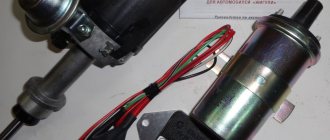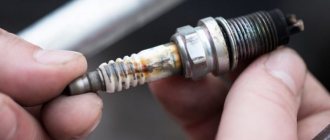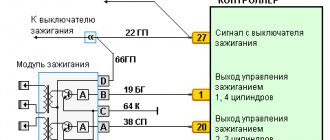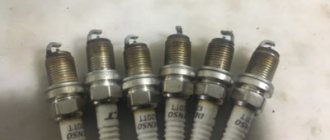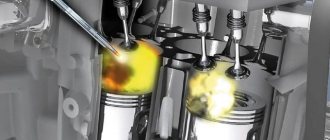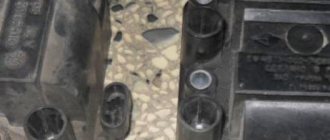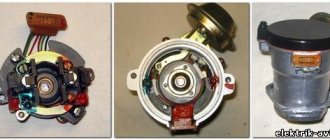A recent novelty of the domestic automobile industry - Lada Vesta - has become widespread among car enthusiasts. Despite the fact that the car has been in production for only a few years, owners are gradually beginning to encounter minor problems and periodic maintenance, which includes replacing spark plugs on Lada Vesta cars. This need is not a shortcoming of the machine or a serious breakdown; timely replacement of small spare parts will help in the future to avoid major repairs of the main moving parts.
↑ Features and purpose of spark plugs on a Lada Vesta car
Plugs are one of the most important components in the ignition system of any car; without them, it simply will not start. Using a discharge on the electrodes, the flammable fuel-air mixture is ignited. Engine power, efficiency and even toxicity of exhaust gases depend on the stable operation of igniters.
Lada Vesta cars produced from the factory can have two types of spark plugs:
- AU17DVRM (Russia);
- Brisk Super DR15YC-1 (Czech Republic).
Both of these models of ignition elements, according to reviews from car owners, have proven themselves well, they last well and do not cause problems.
Which candles to choose?
For an 8-valve engine: 14R-7DU—Ber, RN9Y—Champion, BPR6ES—NGK, W20EPR—Denso, LR15YC-1—Brisk, WR7DCX—Bosch.
For a 16-valve engine: AU17DVRM, DR15YC-1—Brisk, FR7DCU—Bosch, Q20PR-U11—Denso, BCPR6ES—NGK.
The question, of course, is not the name of the manufacturer, but the design features.
The wrong choice of these elements will lead to the fact that they either do not work or will not work.
In addition, for the first option, a regular spark plug wrench is suitable, and for 16-valve models, a reduced size hex wrench is suitable.
Repair procedure
The spark plug gap on the 16-valve Lada Vesta is 1.1 mm.
The process is completely simple if you have the necessary tools. After dismantling, you can assess the presence of a gap between the electrode contacts. Maybe you can just adjust the gap there and there won’t be a need for replacement, but if our 30 thousand kilometers are already behind us, then throw it straight into the trash.
During installation, the engine must be turned off and cooled to ambient temperature.
We will also need a TorxE-8 wrench, 16 head. When replacing an element, it is important to tighten it well, but not excessively, so as not to break the thread. After 30 thousand we will have to repeat the procedure.
One small but important reminder. You need to wrap the candle with your working hand so that you can feel when it goes along the thread. If something happens, you can stop in time by starting the process over again, carefully cleaning the threads. That's all, you can drive until the next replacement.
We won’t spend a lot of time choosing, for the reasons given above. This is not as important a factor as the timing belt, ball joint, or wheel bearing. Of course, there is one significant nuance. Depending on which engine is installed - 8 or 16 valves. Our spare part for each of them will be special, not universal.
If you follow all the Lada Vesta maintenance rules, the spark plugs must be changed every 30 thousand km. Here are our recommendations on how you can do it yourself.
As a rule, factory spark plugs are installed in cars - Brisk super DR15YC-1, so we will describe their replacement. Although other candles do not change the process in any way.
The most basic recommendations that are worth considering before starting work are to carry out replacement when the car’s engine has completely cooled down.
DETAILS: Replacement and repair of the VAZ 2107 gas tank
We disconnect the block from the ignition coil with one click on its clamp with wires.
We unscrew the mounting screw on the coil with the E-8 head and pull out the coil itself from the spark plug well.
Now we unscrew the spark plug itself using a high head (preferably with an extension) 16mm or a special spanner for spark plugs. And we take it out.
If it was not possible to hold the spark plug in the rubber retainer and it remains in the block, then remove it, helping with the ignition coil.
Now screw in a new spark plug. We recommend doing this by hand so as not to damage the threads of the spark plug hole in the cylinder head.
If even the slightest resistance is felt when screwing in, then the spark plug is going past the thread. You need to unscrew it again, clean it completely and carefully screw it in again.
Finally tighten the spark plug to a torque of 25-30 Nm.
The main thing here is not to overdo it; tightening the spark plug too tightly can damage the threads of the spark plug holes in the cylinder head.
From the factory, the car is equipped with Brisk super DR15YC-1 spark plugs.
If the spark plug did not stay in the rubber head retainer and remained in the well, then it can be removed...
If the spark plug does not follow the thread, strong resistance to rotation will be felt. In this case, it is necessary to completely unscrew the spark plug and, after cleaning the threads, re-tighten it.
Attention! Over-tightening the spark plugs can damage the threads in the spark plug holes in the cylinder head.
↑ Signs of wear
It is usually recommended to replace the spark plugs after the vehicle has traveled a certain number of kilometers. It is not advisable to allow the wear of these elements to affect the operation of the engine and the entire ignition system.
But, if the igniters were not replaced in time, or the new ones turned out to be defective, then obvious signs of their malfunction will, first of all, affect the operation of the engine. The first sign is that the engine has become difficult to start and does not pull.
It may also trip or jerk and lose power. Sometimes wear of the ignition elements provokes increased gasoline consumption, as well as poor performance and overheating of the catalyst.
If traces of oil are found on the spark plugs themselves or the threads, this is a clear sign that the reflector caps also need to be replaced.
When to change spark plugs on Vesta
In accordance with the maintenance and operation manual for LADA Vesta, replacement of spark plugs (SZ) should be carried out after 30,000 km of vehicle mileage or once every two years of vehicle operation (MOT 2), depending on the event that comes first.
Signs of spark plug problems may include:
- self-detonation of the fuel mixture in the fuel combustion chamber;
- a sharp drop in engine power;
- sudden heating of the catalytic converter;
- increased gasoline consumption.
↑ Replacement period
For a car, as for any other equipment, it is better to prevent the breakdown of any small spare parts with the help of timely maintenance than to experience difficulties with repairs in the future. Therefore, even when purchasing a completely new car, the owner is given a number of recommendations for operating the car and the necessary periodic maintenance.
AvtoVAZ, among other things, sets timing for replacing spark plugs for cars of the entire model range, including the new Lada Vesta. Plant specialists recommend changing them after every 30,000 kilometers. In fact, the resource of their candles, and any others that will be installed, is approximately twice as long. But due to bad gasoline and polluted air, it is possible that the igniters will fail the car owner at the most inopportune moment if they are not replaced within the specified period.
↑ Replacing spark plugs on Lada Vesta with your own hands
If the car's mileage has not yet reached 30,000 km, but problems with the ignition system have already appeared, it is necessary to check the installation of the spark plugs and measure the gap between them. For a 16-valve Lada Vesta engine, the gap should be 1.1 mm, with the exception of the Renault-Nissan engine, where the gap is adjusted to 0.85-0.95 mm. Sometimes, by adjusting this indicator, problems with the ignition system disappear.
Replacing ignition elements on a Lada Vesta is a simple process that any car enthusiast with little experience in car maintenance can handle. Replacement work must be carried out on a cooled engine. To do this, you need to have a Torx E-8 spark plug wrench and a high 16 socket with an extension, and to work with an 8-valve engine, it is enough to have a 21 wrench.
The procedure for replacing spark plugs on a Lada Vesta car on an 8-valve engine is simpler than on a 16-valve engine, since the installation location of the electrodes is on the surface of the cylinder block. Therefore, to replace them, it is enough to remove the wires, unscrew some of the replaced elements, and put new ones in their place. Then put the wires back in place.
In contrast, on a 16-valve engine, the spark plug holes are recessed into the block, so the plastic engine cover must first be removed. To do this, it is pulled sharply upward. Then the harness is pulled out of the ignition coil, and the coil itself is unscrewed with a Torx E-8 wrench and removed from the spark plug well. Used spark plugs are unscrewed with a sixteen key, and new ones are installed and screwed in their place. It is best to wrap them by hand in order to feel in a timely manner if the candle does not go along the thread of the spark plug hole.
Tighten the igniter with a torque of 25-30 Nm. Having completed the work, install all the dismantled parts in their places and connect the harness.
Technical characteristics of spark plugs for Lada Vesta
Foreign manufacturers do not label sets of candles according to a standard system, so you need to rely on catalogs. Russian products have certain markings. The production date must be written (the last two digits indicate the year); factory name or trademark; type of candle.
An alphanumeric code describes technical characteristics. The first letter indicates the type of thread, dimensions, heat rating, thread length, and the presence of a built-in resistor. Since the spark plug serves to ignite the combustible mixture, a gap of a certain size is arranged between its electrodes. It depends on the engine type. For Vesta, the recommended size is 1-1.1 mm. Due to the vehicle's mileage, the gap may increase. At each scheduled maintenance, it is necessary to check and adjust the gap size.
↑ Selection of spark plugs
Lada Vesta has four engine options. One of them (the 1.6-liter VAZ-11189 8-valve engine) is no longer produced, but such cars are constantly seen on the roads. The remaining engines have 16 valves:
- VAZ-21129, 1.6 l;
- VAZ-21179, 1.8 l;
- Renault-Nissan HR16de/h4m, 1.6 l.
Depending on the type of engine, recommendations for selecting spark plugs for Lada Vesta may differ. According to the recommendations of the AvtoVAZ plant, copper or nickel igniters made in Japan by Denso or NGK, as well as English or German spare parts, are suitable for installation on the entire Lada model range. In addition to the manufacturer and the material from which they are made, spark plugs can also vary in design and have one, two or more electrodes.
For the 8-valve Lada Vesta engine, the installation of the following spare parts is recommended:
- RN9YC (Champion, England);
- W20EPR (Denso, Japan);
- BPR6ES-11 (NGK, Japan);
- A17DVRM (JSC Robert Bosch Saratov, Russia);
- WR7DCX (Bosch, Germany);
- 14R-7DU (Beru, Germany);
- LR15YC-1 (Brisk, Czech Republic).
16-valve engines VAS-21129 and VAZ-21179 operate on the following elements:
- FR7DCU (Bosch, Germany);
- Q20PR-U11 (Denso, Japan);
- BCPR6ES (NGK, Japan);
- AU17DVRM (JSC Robert Bosch Saratov, Russia);
- DR15YC-1 (Brisk, Czech Republic).
The 16-valve Renault-Nissan Hr16de/H4m operates on the following elements:
- nickel LZKAR7D-9 (NGK, Japan);
- platinum PLZKAR6A-11 (NGK, Japan).
Some car owners purchase replacement iridium spark plugs (for example, Denso IQ20). Theoretically, such elements of the ignition system should provide lower fuel consumption, extend the life of the catalyst and ensure consistently good performance at both high and low speeds. But, judging by the reviews of owners who tested different types of spark plugs, no significant difference in engine performance was noticed. The main thing is that they meet the requirements placed on them.
Spark plugs must be resistant to high temperatures arising in the combustion chamber (up to 1000°C), have resistance to thermal shock, be inert to substances formed during fuel combustion, operate reliably at a voltage of 40 kV, and their thermal conductivity must meet the standard.
Spark plugs Lada Vesta
Spark plugs for Vesta need to be selected based on the cost of the engine. Lada Vesta has 4 gasoline engines in its arsenal:
- 8-valve VAZ-11189, 1.6 l. At the moment, the car is no longer produced with this engine.
- 16-valve VAZ-21129, 1.6 l
- 16-valve VAZ-21179, 1.8 l
- 16-valve Renault-Nissan HR16de/h4m, 1.6 l. It is planned to be released with this engine in the near future.
From the assembly line in Lada Vesta engines you can find 2 types of spark plugs:
- AU17DVRM - installed on the first releases of Vesta. Price – from 60 rub/piece. Manufacturer: Russian company STANDARD (Engels). The central electrode has a copper core. This model of spark plugs maintains its declared service life (30 thousand km) normally. According to reviews from car owners who use such spark plugs, after 15 thousand kilometers the engine begins to have difficulty starting in winter if the air temperature is below -15 degrees Celsius.
- Brisk Super DR15YC-1 – Manufacturer – Brisk (Czech Republic). Average price – 55 rub/piece. The material of the central electrode is copper. More common than the previous model. According to reviews from Vesta owners with these spark plugs, no operational problems were found. The lifespan declared by the factory is worked out well.
Spark plugs AU17DVRM
Spark plugs Brisk Super DR15YC-1
According to the factory maintenance regulations, spark plugs on Lada Vesta must be replaced every 30 thousand kilometers. And although their actual service life is longer, such a replacement interval for spark plugs is recommended due to domestic harsh operating conditions (low-quality fuel, polluted environment, etc.)
↑ Where to buy
You can purchase spark plugs at a regular auto parts store. The simplest copper parts are usually in stock, and you don’t have to wait for them to be ordered and delivered. If the chosen model is not available at the moment or there is no store nearby, then it will not be difficult to order candles of the chosen brand and manufacturer through the online store.
In this case, you can pick them up from the point of issue yourself or pay for delivery by courier. Typically, prices when ordering online are lower than in the same retail store.
↑ Cost of a set of spark plugs
Spark plugs are sold individually or as a set. The simplest copper elements can be bought for 60-70 rubles apiece, so the set will cost 240-300 rubles. Nickel spare parts will cost a little more, more than 120 rubles apiece.
Some types of spark plugs, especially for the Renault-Nissan Hr16de/H4m engine, can cost 380-390 rubles per unit, and iridium ones - more than 500 rubles. In some stores, the price for individual models reaches 1000 rubles per piece, while their service life is approximately twice as long as that of others.
Each driver must decide on the choice of spark plugs based on his own or someone else’s experience. The price of different igniters may differ by 10 times or more, but their ability to perform their functions has little bearing on this. The main thing is not to exceed the period of use of spark plugs declared by the car manufacturer, then the performance of the ignition system and the driving system of the car will be stable and will not fail.

